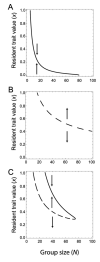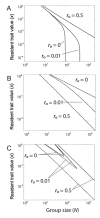Synergy and group size in microbial cooperation
- PMID: 22854073
- PMCID: PMC3635123
- DOI: 10.1086/667193
Synergy and group size in microbial cooperation
Abstract
Microbes produce many molecules that are important for their growth and development, and the exploitation of these secretions by nonproducers has recently become an important paradigm in microbial social evolution. Although the production of these public-goods molecules has been studied intensely, little is known of how the benefits accrued and the costs incurred depend on the quantity of public-goods molecules produced. We focus here on the relationship between the shape of the benefit curve and cellular density, using a model assuming three types of benefit functions: diminishing, accelerating, and sigmoidal (accelerating and then diminishing). We classify the latter two as being synergistic and argue that sigmoidal curves are common in microbial systems. Synergistic benefit curves interact with group sizes to give very different expected evolutionary dynamics. In particular, we show that whether and to what extent microbes evolve to produce public goods depends strongly on group size. We show that synergy can create an "evolutionary trap" that can stymie the establishment and maintenance of cooperation. By allowing density-dependent regulation of production (quorum sensing), we show how this trap may be avoided. We discuss the implications of our results on experimental design.
Figures





Similar articles
-
Microbial communication, cooperation and cheating: quorum sensing drives the evolution of cooperation in bacteria.PLoS One. 2009 Aug 17;4(8):e6655. doi: 10.1371/journal.pone.0006655. PLoS One. 2009. PMID: 19684853 Free PMC article.
-
Interspecies evolutionary dynamics mediated by public goods in bacterial quorum sensing.Phys Rev E. 2021 Jan;103(1-1):012403. doi: 10.1103/PhysRevE.103.012403. Phys Rev E. 2021. PMID: 33601496
-
Behavioral heterogeneity in quorum sensing can stabilize social cooperation in microbial populations.BMC Biol. 2019 Mar 6;17(1):20. doi: 10.1186/s12915-019-0639-3. BMC Biol. 2019. PMID: 30841874 Free PMC article.
-
Bacterial Quorum Sensing and Microbial Community Interactions.mBio. 2018 May 22;9(3):e02331-17. doi: 10.1128/mBio.02331-17. mBio. 2018. PMID: 29789364 Free PMC article. Review.
-
Acyl-homoserine lactone quorum sensing: from evolution to application.Annu Rev Microbiol. 2013;67:43-63. doi: 10.1146/annurev-micro-092412-155635. Epub 2013 May 15. Annu Rev Microbiol. 2013. PMID: 23682605 Review.
Cited by
-
The evolution of strategy in bacterial warfare via the regulation of bacteriocins and antibiotics.Elife. 2021 Sep 7;10:e69756. doi: 10.7554/eLife.69756. Elife. 2021. PMID: 34488940 Free PMC article.
-
A tale of two contribution mechanisms for nonlinear public goods.Sci Rep. 2013;3:2021. doi: 10.1038/srep02021. Sci Rep. 2013. PMID: 23779102 Free PMC article.
-
On inferring evolutionary stability in finite populations using infinite population models.J Math Biol. 2021 Jul 31;83(2):21. doi: 10.1007/s00285-021-01636-9. J Math Biol. 2021. PMID: 34331596 Free PMC article.
-
Cooperation, clumping and the evolution of multicellularity.Proc Biol Sci. 2015 Aug 22;282(1813):20151075. doi: 10.1098/rspb.2015.1075. Proc Biol Sci. 2015. PMID: 26246549 Free PMC article.
-
Core principles of bacterial autoinducer systems.Microbiol Mol Biol Rev. 2015 Mar;79(1):153-69. doi: 10.1128/MMBR.00024-14. Microbiol Mol Biol Rev. 2015. PMID: 25694124 Free PMC article.
References
-
- Archetti M. Cooperation as a volunteer’s dilemma and the strategy of conflict in public goods games. Journal of Evolutionary Biology. 2009a;22(11):2192–2200. ISSN 1420-9101. - PubMed
-
- Archetti Marco. The volunteer’s dilemma and the optimal size of a social group. Journal of Theoretical Biology. 2009b;261(3):475–480. ISSN 1095-8541. - PubMed
Publication types
MeSH terms
Grants and funding
LinkOut - more resources
Full Text Sources
Other Literature Sources

